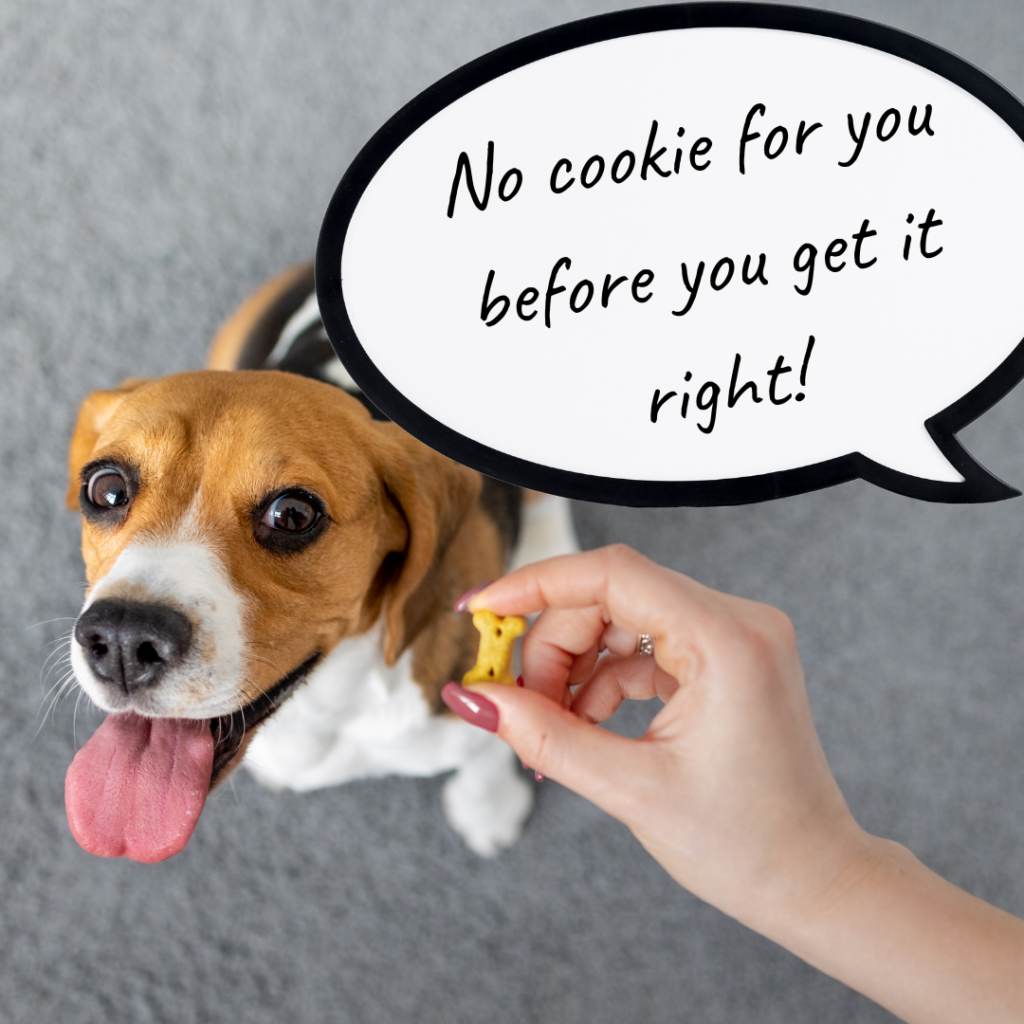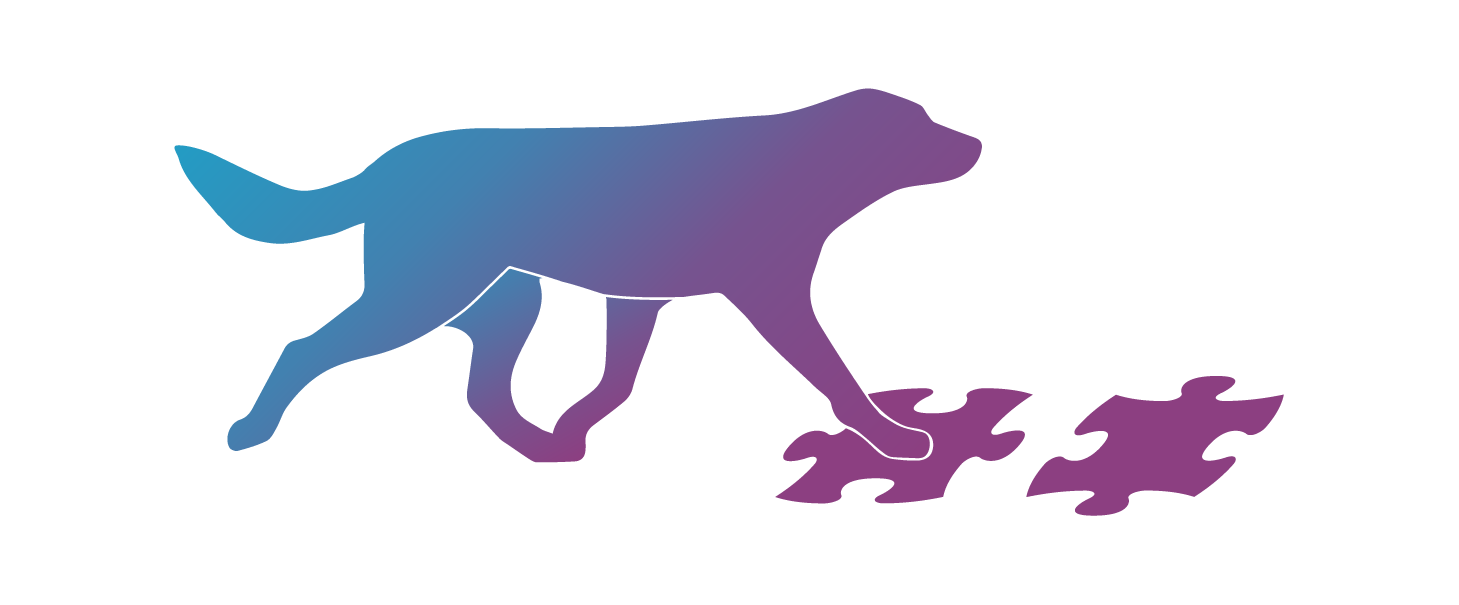Movement Puzzles are pattern movement exercises where the dog moves between 2 bowls – the 2 bowl game – and does different exercises independently from their human (no handler cues!) while moving from bowl to bowl.
The goal of these exercises is to provide dogs with an environment and structure to SAFELY – without pressure or distractions – practice things that may be difficult or challenging FOR THEM. Be it moving on elevated surfaces, stepping onto moving/tilting surfaces, move through tight spaces, run through noisy stuff, turning around in tight areas and so much more!

A typical example of a Movement Puzzle – dog moves from bowl to bowl and does different exercises on her way: moving through a narrow space, stepping over gaps, moving through a curtain of noisy stuff. All done independently in a pattern and without handler cues
As a result, Movement Puzzles are a powerful training tool to improve dog’s CONFIDENCE in new situations, BODY AWARENESS, COORDINATION, understanding of where their bodies are in space and how they move.
And yes, Movement Puzzles are like fun DIY obstacle courses that you can set up in your living room or garden, using the equipment and stuff you can (mostly) find at home 😉
Movement Puzzles come in different shapes and sizes!

Movement Puzzles can be big and done in a circle and with the handler staying still…

… they can also be done in a gentle arc or even a straight line from bowl to bowl!

And they can be small! Consisting of just one exercise, done in your living room…

… using the space and equipment available to you!
Key elements
For Movement Puzzles to actually work on boosting your dog’s confidence and coordination, they need to follow some key rules:
1. All the exercises are taught with the 2 bowl game pattern and without handler cues.
It’s important that the dog does the exercises independently, not looking at the handler or following their hand or food lure that may distract them or convince them to do an exercise they don’t fully understand or feel comfortable doing. From the coordination training perspective, the dog must be able to focus on seeing what’s in front of them, so that they can concentrate on their movements and coordination, not on what the handler is doing.
This is achieved by teaching the dog the pattern of moving between 2 bowls, doing an exercise on the way and getting the reinforcement in the bowl. Using this pattern makes teaching new exercises and adding different obstacles into puzzles super quick and easy!
The 2 bowl game is often confused with the popular Vito’s game. There are some small but important differences between the two that I will cover in a separate post.
2. Focus is on how the dog moves, not just teaching them to do something any way.
Example: Exercise criteria is for the dog to move around a cone. In Movement Puzzles HOW the dog moves around the cones is more important than the fact that they move around the cones. In Movement Puzzles it matters what gait the dog is using, how fast they move, how balanced their movement is, how confident they are when moving around the cone.
Imagine a scenario. Let’s say you are in a natural parkour class, learning how to move in different ways using the nature as your playground. Imagine having a row of 10 rocks in front of you and you know the exercise is about the rocks, but you don’t know what it is! Only your coach knows that the goal is to step from one rock to another.
So you start offering different things and your coach tells you when it’s warm or cold. You may try touching the rock with your hand, lifting it up, stepping up on it. Gradually you may get to the full exercise – stepping from rock to rock, but chances are that your movements are a bit clumsy. Maybe you had to stop to balance. Or switch your feet in odd places. Or instead of stepping you had to jump.

Imagine trying to figure out the criteria of stepping from one rock to another just by your coach telling you “Warm” or “Cold” whenever you make a movement!
Now imagine that you already know the criteria – stepping from one rock to another. And you start moving over them back and forth. Knowing exactly what you need to do, but now your focus is on balancing, making your movements more efficient. Chances are you will get better and better at it, your movements better coordinated and smoother.
Both types of exercises work on coordination, but differently. While most of the dog training tends to be more like the first exercise – you trying to figure out what the criteria is and never getting a chance to polish your coordination and movements – Movement Puzzles aim to be the second exercise. Where the dog already knows what the criteria is, and is focusing on achieving it in the best possible way.
This results in smoother movements, dogs being able to control their speed better and understanding of not just how to somehow meet the exercise criteria, but how to do it well.
However, this is tricky to communicate to dogs! Which is why in Movement Puzzles we use super clear setups by constantly adjusting the positions of the bowls, cones and other props to make sure the dog wouldn’t switch from “I know what to do!” to “What’s the exercise criteria again?”.
3. Because these exercises and setups are often challenging to the dog, they must have a way to say “No, this is too much.”
Dog saying “No” can look like hesitation before returning to the exercise, avoiding a prop, jumping or rushing over equipment, taking shortcuts between the equipment and the handler.
People often mistake these behaviors as the dog “not understanding the exercise” or “dog made a mistake”. Common solutions are withholding the reinforcement (i.e. not giving the dog the treat before they’ve done the “correct” behavior) or saying “No” to the dog when a “mistake” happens. In Movement Puzzles these approaches will backfire quickly – dogs will discover that despite them trying to communicate their discomfort about the exercise, they have to do it anyway just to earn the reinforcement!
In Movement Puzzles we never withhold the reinforcement or tell the dog they were wrong. Instead, we reinforce every repetition and use the dog’s behavior as information to split the exercise into smaller steps.

Withholding the reinforcement and not giving a treat when the dog made a “mistake” often comes so automatically, we don’t even think about it! This can quickly backfire in Movement Puzzles – we never withhold the reinforcement during these exercises!
Follow these key rules and you will get a happy, confident canine partner who’s independently and without hesitation willing to do all kinds of fun puzzles with you 😉 Not to mention your dog feeling more confident in daily life and sport, navigating tricky situations with ease, feeling in control of their own bodies and movements. What’s there not to love?! As a bonus, you will know how to read your dog better and set up exercises that they are physically and mentally comfortable with
Read next on how Movement Puzzles started.
If you too want to get started with this fun training concept, head over to this page to get the free How To instructions for the 2 bowl game pattern.
Happy training and I’ll see you in the next post!
Mari
Enjoyed this post? Leave me a comment and share this post with your friends using the links below 👇
